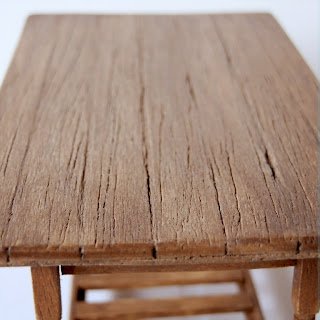Now some accessories. Even before I build the shelves, I decided to make some accessories too.
Minha loja vai diversificar sua linha de produtos. Inicialmente eu só ia colocar rolos de tecidos para vender. O projeto inicial, começado em 2007, era parte de um projeto de grupo e outras pessoas teriam lojas relacionadas a moda, acessórios, aviamentos, etc. e eu não poderia "fazer concorrência" a elas :) Agora o grupo retomou o projeto mas não posso mais participar dele (algo relacionado à estrutura, que agora tem que ser uma das especificadas pelos líderes). Isto me liberou para expandir minhas opções. Decidi então incluir fitas, linhas, rendas, e algumas máquinas de costura também. Coisas que uma costureira precisaria na época.
My store will diversify its range of products. Initially I was going to have only bolts of fabric there. The initial project was part of a group one and other people would have other stores related to fashion, notions, etc. and I couldn't overlap their target market :) Now that I've been disassociated from the group project (something related to the building structure, I'd have to use one designed by the new owners), I'm free to expand my options. I decided to include ribbons, threads, and some sewing machines too. Anything a seamstress would need back then.
Então achei na internet estes suportes de carretéis de linha da época, em ferro fundido. Muito charmosos.
And I saw these charming wrought iron thread holders on the internet.

Decidi fazer algo similar, não só para exibir linhas à venda, mas ele mesmo poderia ser comprado. Usei peças que encontrei em lojas de artigos para montagem de bijutereria e contas pequenas. "Envelheci" a aparência brilhante das peças usando aquabetume.
I decided to make something similar, not only to display the threats for sale at the store, but which could be bought as well. I used jewelry findings, earring pins and some tiny beads. I "aged" the shiny look of the findings using water based bitumen.
Os carretéis de linha são de um kit cortado a laser que comprei quando fui a Chicago em 2010. São uma criação de Bonnie Lavish. Acho que é o mesmo kit que pode ser comprado na Dragonfly online.
The thread spools were a laser cut kit I bought when I went to Chicago in 2010. They are by Bonnie Lavish. I believe it's the same kit you can buy from Dragonfly.
Bem, precisava também de um outro jeito de armazenar/expor os carretéis. Só para uma loja não seria o suficiente. Então achei uma imagem de caixa antiga da coats, fiz uns printáveis com ela.
Well, just this display would not be enough. To be realistic, the store had to have more thread reels to sell, right? So I found a picture of an old coats reels box on the internet. I made a printable based on it.
Usei uns torneados em miniatura que tinha comprado há algum tempo e fiz mais carretéis de várias cores. Você acha esses torneados na Dragonfly também.
Then I used some tiny turnings I've had for some time - which you can also buy at Dragonfly - to make more thread reels.
Aí colei um carretel de cada cor na lateral de cada caixa (caixa amarela para fios de algodão, caixa azul para de seda).
Then I glued one reel of each color/thread on the side of each box. Yellow for cotton, blue boxes for silk.
Esse recurso é muito usado ainda hoje: amarra-se uma "amostra" do produto na lateral da caixa que está na prateleira para o vendedor saber o que tem dentro.
This resource is still in use today: they tie a "sample" of the item on the front side of the box that is on the shelf so that the salesperson knows what is inside.
 |
| Uma loja da cidade. Tem tudo o que vc imaginar! A variety store in the city. They have anything you can imagine! |
It's so common that Coats even created a modern plastic display to be used like that!
Também fiz uns carretéis de fitas e rendas, para serem colocados em um suporte em uma das prateleiras que ainda vou construir. Eu precisava saber o tamanho que esses suportes iam ter para poder construir as prateleiras com o tamanho/espaço correto... :)
I also made some ribbons and laces reels, to be placed on a special display on the shelf I'm still to build. I need to know how large they'll be so I can build the shelf accordingly.. :)
 |
| o suporte será tingido com a mesma cor da estante. The brackets will be stained the same color as the shelf. |
After I finished my ribbon support, I found a great tutorial for a ribbon display at Nono Miniatures. Maybe next time I'll use it, but you can use it now!
Pode não parecer, mas levei mais tempo fazendo essas "coisinhas" do que a mesa da postagem anterior!...
Who has never made miniature cannot imagine this, but it took me longer to finish these "little things" than it took me to make the whole table from the previous post!...
.
 |
| Obrigada! Thank you! |




















































